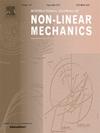Modal and non-modal linear stability analysis of plane channel flow through a Darcy-Brinkman porous medium with symmetric and asymmetric slippery walls
IF 2.8
3区 工程技术
Q2 MECHANICS
International Journal of Non-Linear Mechanics
Pub Date : 2025-01-16
DOI:10.1016/j.ijnonlinmec.2025.105015
引用次数: 0
Abstract
This study investigates the linear stability and transient growth behavior of fluid flow in a channel influenced by varying slip boundary conditions, porous parameters, and viscosity ratios. The Chebyshev Collocation Method (CCM) was used to solve the modified eigenvalue problem, leveraging basic routines of MATLAB 2024b and the QZ algorithm for high precision in capturing stability characteristics. Using modal and non-modal stability analyses, the results reveal that boundary conditions—no-slip, symmetric slip, and asymmetric slip—strongly influence flow stability, eigenvalue spectra, and velocity profiles. With increasing slip length, symmetric slip enhances stability by raising the critical Reynolds number, while asymmetric slip introduces complex stability dynamics, particularly at higher viscosity ratios. Non-modal analysis highlights transient energy growth, pseudospectrum, and contour plots, especially under asymmetric slip, suggesting that disturbances could cause significant short-term deviations even in stable regimes. The results from the modal analysis appear to align well with those from the non-modal analysis.
求助全文
约1分钟内获得全文
求助全文
来源期刊
CiteScore
5.50
自引率
9.40%
发文量
192
审稿时长
67 days
期刊介绍:
The International Journal of Non-Linear Mechanics provides a specific medium for dissemination of high-quality research results in the various areas of theoretical, applied, and experimental mechanics of solids, fluids, structures, and systems where the phenomena are inherently non-linear.
The journal brings together original results in non-linear problems in elasticity, plasticity, dynamics, vibrations, wave-propagation, rheology, fluid-structure interaction systems, stability, biomechanics, micro- and nano-structures, materials, metamaterials, and in other diverse areas.
Papers may be analytical, computational or experimental in nature. Treatments of non-linear differential equations wherein solutions and properties of solutions are emphasized but physical aspects are not adequately relevant, will not be considered for possible publication. Both deterministic and stochastic approaches are fostered. Contributions pertaining to both established and emerging fields are encouraged.

 求助内容:
求助内容: 应助结果提醒方式:
应助结果提醒方式:


